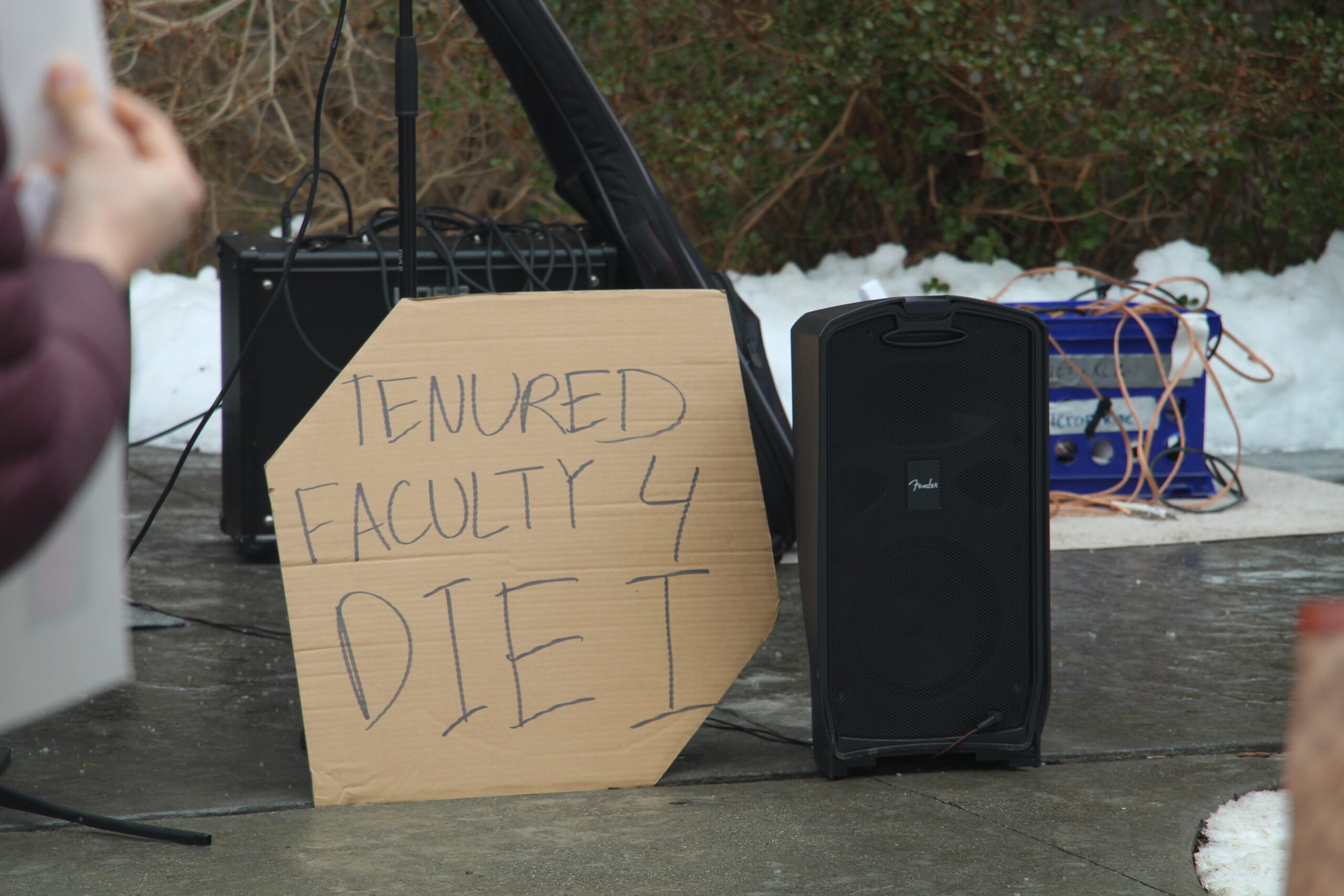A yellow string was draped diagonally across the back of the stage and a tall red ladder with silver rungs sat in the corner. The scene was set for Adele Myers’s performance entitled “Einstein’s Happiest Thought.” Myers was on the dance faculty of Connecticut College from 2006 until 2013, and “Einstein’s Happiest Thought” has been a project-in-residence at the College for the past two years.
The performance focused on the themes of falling and flying, particularly the moment before a fall. Myers explained the performance as addressing “the anticipation of taking risk.” She asked: “What does that sensation feel like…can we perform that sensation and can the audience experience that sensation as they watch?”
The project started a few years ago as part of a Sherman Fairchild Foundation Grant to the College, which brings faculty from various departments together to teach a series of interdisciplinary courses. This is how Blanche Boyd, Connecticut College’s Weller Professor of English and Writer-in-Residence, became involved in the process. At one point the group of faculty was throwing ideas around when Boyd said in exasperation, “Let’s just jump off a plane!” This idea didn’t get approved. Instead, they took the students to trapeze school.
After the Fall 2010 semester was over, Myers wanted to take the project further with her company. It is now embarking on a national tour. Many people were involved in the process, and Myers even received input from her students here at Conn. Professor David Dorfman, chair of the Dance Department, mentioned how inspirational it is to be working in the environment of a college, where knowledge is truly at one’s fingertips. Dorfman said of Myers, “I saw her work change, and I think that some of it had to do with being pleasantly ensconced in this academic institution that really encourages interplay among different departments and disciplines.”
With modern dance, people have a tendency to instantly react with, “I don’t get it.” Myers’ response to that is, “Yes, you do. You just need the permission to say that whatever you experience is what it is.” In the program, Myers provides an explanation of her performance, but she prefaces it: “If you want to know the answer, read on. If not, skip this part.” This enables the audience to discover the intended meaning behind the performance or to come up with their own interpretation.
The cast of “Einstein’s Happiest Thought” consisted of four dancers: Tara Burns, Raphaëlle Kessedjian, Kellie Lynch and Amber Morgan. Each comes from a different background in dance; despite this diversity, they worked together coherently onstage — at times, perfectly in sync. “They can occupy space with such force and such power and such abandon,” Myers said.
These four dancers weren’t the only ones onstage. Recent graduate Morgan Griffin ’12 was featured in the performance as “The Walker.” Her role was to slowly walk across the stage and up the ladder throughout the entire performance. As she walked, she held onto a second yellow string, which followed her as she moved across the stage. Griffin’s movements were so small and infrequent, and I was so distracted by the motion of the other dancers that I barely noticed she was moving. Before I knew it, she was already halfway across the stage.
Myers explained that Griffin represented “a measure of time and space and its consistency.” The dancers reflected what was going on inside her. Clad in yellow, Griffin acted as a kind of yellow string herself, threading the performance together. In fact, one of the audience members later commended Griffin on her role, saying, “Standing still is the hardest thing in the world.”
The presence of the color yellow was no coincidence. Myers explained that a single color is usually a part of her work, and when she first heard the words “Einstein’s happiest thought,” the color yellow came to her mind. Yellow was symbolic to Myers and she said, “It became more about hope and wonder.”
The title originally came from Boyd. Myers asked Boyd for any material she had written on the subject of falling or flying. Within this collection Myers came across a quotation referencing Einstein’s happiest thought. This refers to a “thought experiment” that led to Einstein’s Theory of Relativity. Specifically, it’s about the different ways we each can experience the same quantity of time and space and gravity. Myers said, “I would call this whole thing a thought experiment.” The whole creative process was itself a thought that developed continually.
Physics was clearly an important aspect of this work, in keeping with the interdisciplinary nature of the piece. Dorfman said, “I think that this notion of where physics and the physical world impact our emotional and intellectual world is really interesting, fertile ground.”
Myers said, “Let’s say, you right now…in ten minutes you have something so fun you’re about to do, and you’re so excited, and then in ten minutes I have something that I’m dreading, right? The way we’re going to experience that ten minutes is totally different because of what is at the end. It’s going to go really slow[ly] for you because you can’t wait, and for me it’s going to go really fast because I don’t want it to happen. We’re experiencing the same amount of time but we’re experiencing it completely differently.”
Myers has a fear of heights, but describes it as an “excited fear.”
Regarding her experience at trapeze school, she said, “I was surprised by the fact that as I was climbing the ladder, that’s when I had the most fear. And I noticed that my sense of time, and my sense of the space around me and my heartbeat got altered as I got closer to the top…That moment became more interesting to me than the actual trapeze.” Dorfman pointed out, “Adele is dealing with all those different states: the anticipation of a fall, the start of it, the free-fall, the recovery.”
For me, the moment of letting go is the scariest part. Whether it’s going on a zip line, plunging into icy water or ripping off a Band-Aid, that moment when you force yourself to leave the ledge is the most terrifying. Myers said that’s the part she loves most. She admitted, “I am a little bit of a thrill-seeker, so as much as I have the fear, I kind of like that sensation. The scariest part for me is anticipating. In this work I am making myself sit in the anticipation of a risk.” Doing what makes you uncomfortable is a very powerful way of creating art.
Myers recounted an experience she had as a freshman in college, when she was in her first modern dance class ever, with Viola Farber. She was going across the floor when she fell down. Viola stopped the class and the piano and said, “Now that is dancing.” Myers said that those words have always stuck with her. She said, “Why not? If you fall down and you get embarrassed or you get a little bit hurt, wasn’t it worth the thrill?”










